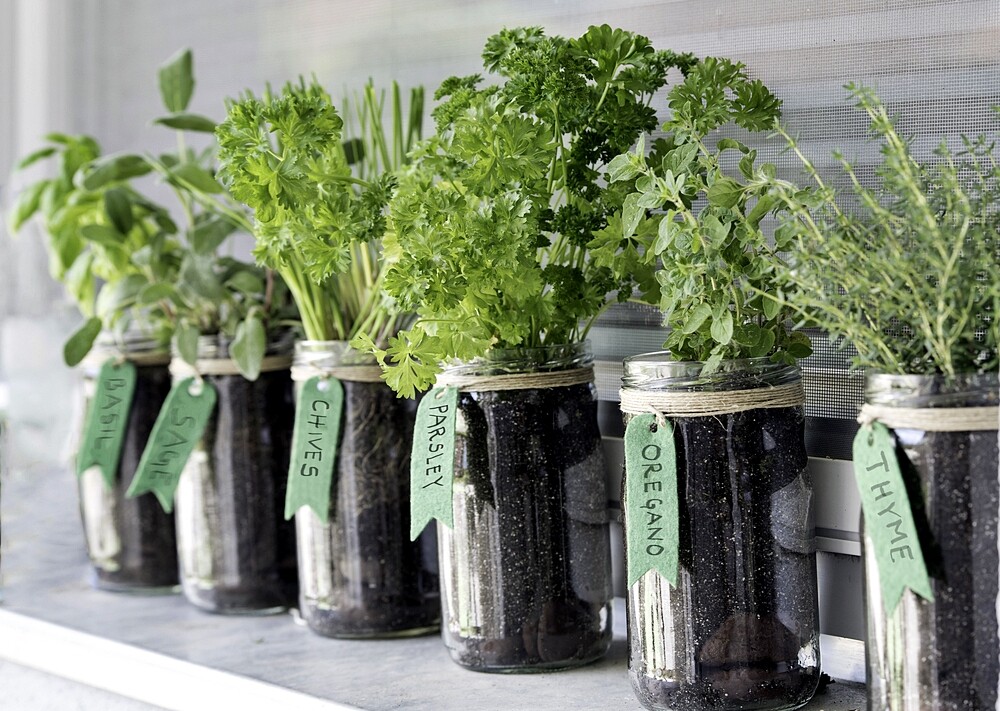A herb garden in the kitchen or on the balcony always brings fresh herbs to the table, which not only taste good but are also really healthy. You can learn how to plant herbs here.
Planting herbs: Date
If you plant your herbs outdoors, there are a few things you need to consider:
- Since ground frost can still occur until the end of April or even the beginning of May, you should not put out preferred herb plants until after this time frame.
- Usually in mid-June, cold air (the so-called sheep cold) breaks in again, which can damage your plants. It is best to cover sensitive varieties with a fleece until this time.
Substrate
- Herbs develop a stronger aroma in lean soils. Therefore, do not use (pre-fertilized) potting soil for planting herbs, as it does not meet the requirements for herbs.
- Instead, herbs in pots or tubs require special herbal soil (pay attention to organic quality) or in the bed normal garden soil, which is permeable and has a normal nutrient content. Only in the pot may the soil be somewhat more nutritious.
- Depending on the type of herb, the substrate can also be mixed with sand, horn shavings, lime gravel or compost to make it thrive better.
- Never use mineral-chemical fertilizers for herbs. However, you can add compost to the bed once a year before the cultivation starts. Otherwise, organic mixed fertilizers or fertilizer with horn meal can be used if growth slows down. In the pot, on the other hand, diluted herbal manure is a suitable fertilizer that can be used every few weeks. Watery extracts from compost are also suitable here.
Planting herbs: How to do it
To plant herbs, you will need young plants that have either been grown by hand or come from a shop. Tip: Herbs from the supermarket often die quickly, as they were pulled up too quickly and are more susceptible. Garden centres and nurseries, however, have higher quality plants.
Important: Always observe the location of the herbs and arrange your herb garden or tub accordingly. Thyme, lavender or basil, for example, need a sunny location. Dill, fennel and parsley thrive in partial shade.
- The bed or tub should be free of weeds and stones. Loosen up the substrate or soil.
- Place the herb pots in a tub or bowl full of water so that all air escapes and they soak up the water.
- If you want to use the plants in the tub, you should create a drainage under the ground and above the water drain. This can consist of, for example, clay fragments, expanded clay or gravel. In this way you prevent waterlogging.
- Herbs that grow in a sunny location dry out faster. You can counteract this by placing a layer of sand in a pot of clay or terracotta and then planting the plants in soil. Both the sand and the clay or terracotta store moisture. A layer of bark mulch later on in the soil also prevents the plants from drying out.
- Dig a hole for each herb seedling and note that the individual plants need specific distance to other plants.
- Remove the herb pots and insert the plant. Fill up the hole with earth, press it firmly into place. Afterwards only water and your herb bed is ready!
- Do not forget to water regularly afterwards and always remove dried leaves or stems.
Tip: Harvest the herbs in the morning, as this is when they have the most essential aromatic substances.
Which herbs go together
- When planting you should always pay attention to which herbs harmonize together in a bed or tub. They then favour each other when growing and protect each other against diseases or fungal attack. In addition, pests can be warded off quite naturally if they are cleverly combined, for example if one plant attracts certain insects in the garden that fight the pests on another neighbouring plant.
- Some perennial herbs may not be compatible with annuals. The perennial herbs love consistency and therefore do not want to have another plant next to them all the time!
Annual herbs include, for example:
- Dill
- Basil
- Marjoram
- Rosemary
- Chamomile
- Nasturtium
- Parsley
Perennial herbs include:
- Oregano
- Sage
- Caraway seeds
- Tarragon
- Thyme
- Chives
- Fennel
- Lemon balm
Very good bed neighbours in the garden are however:
- Basil & Rosemary
- Sage, savory, oregano
Which plants need especially much space?
There are certain herbs that don’t like to be in close proximity: you should therefore use them in a single pot or at a sufficient distance from the next plant. The following plants require a particularly large amount of space:
- Tarragon
- Melissa
- lovage
- Sage
- Lovage
- Wormwood
- Mugwort
Where can you grow herbs?
- Balcony railing
- Bucket
- Clay pots
- Hanging traffic light
- Bed
Tips for the most important kitchen herbs
- Basil: sunny, warm place; lots of water
- Chives: preferably half-shade and a separate pot; keep soil moist
- Thyme: sunny, warm location; nutrient-poor, sandy and dry soil
- Parsley: nutrient-rich, moist soil in partial shade
- Tarragon: sunny, warm place; damp soil
- Dill: needs a lot of space and thrives best in its own pot or with sufficient distance

